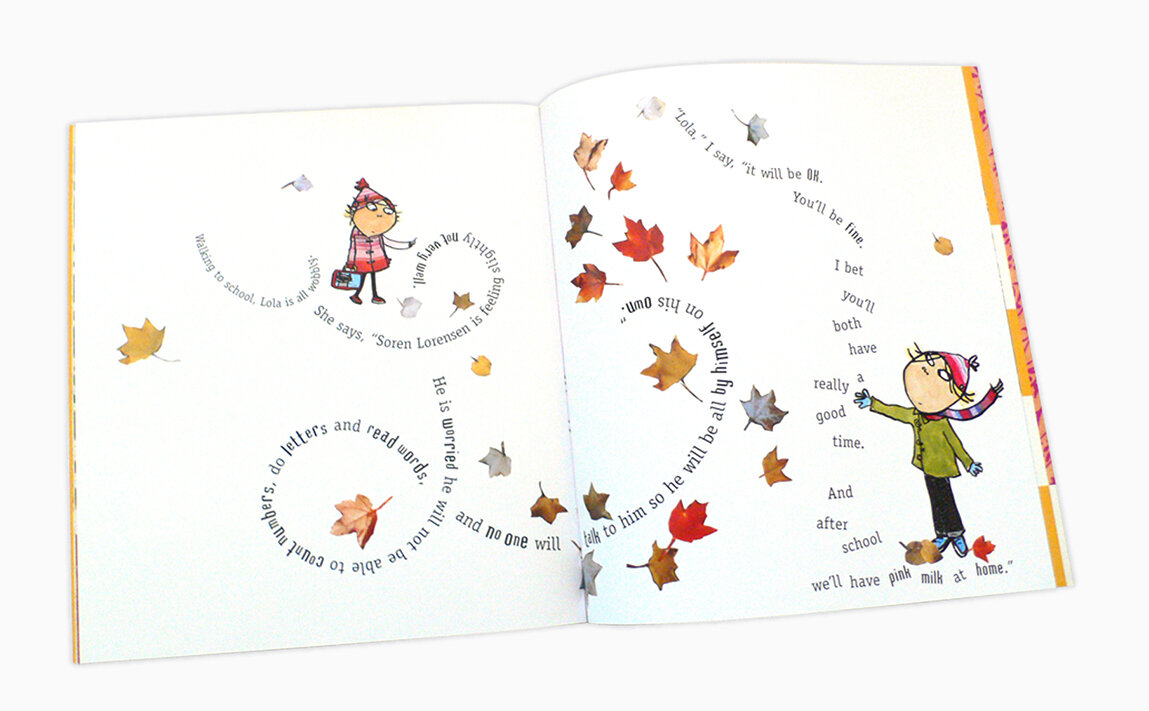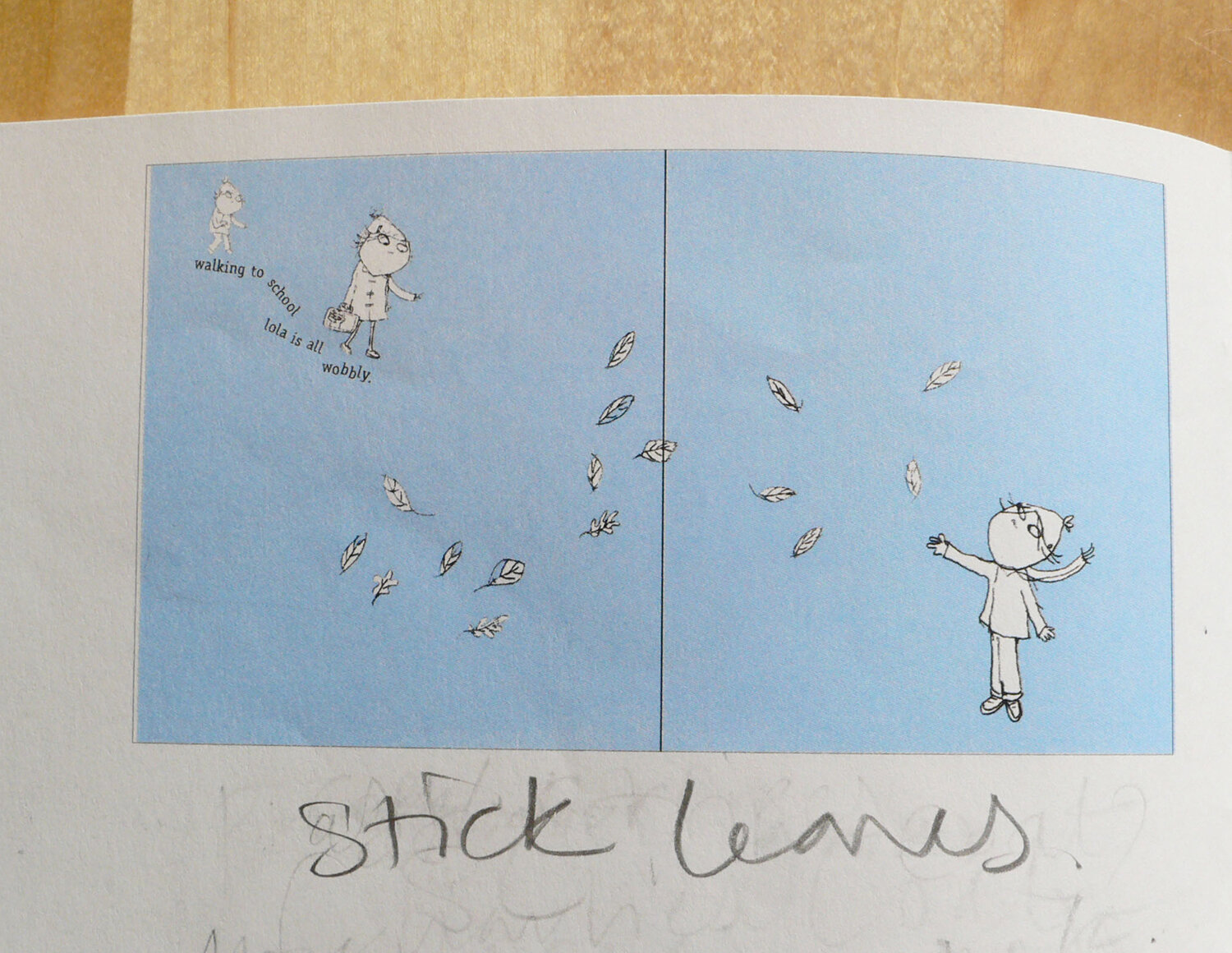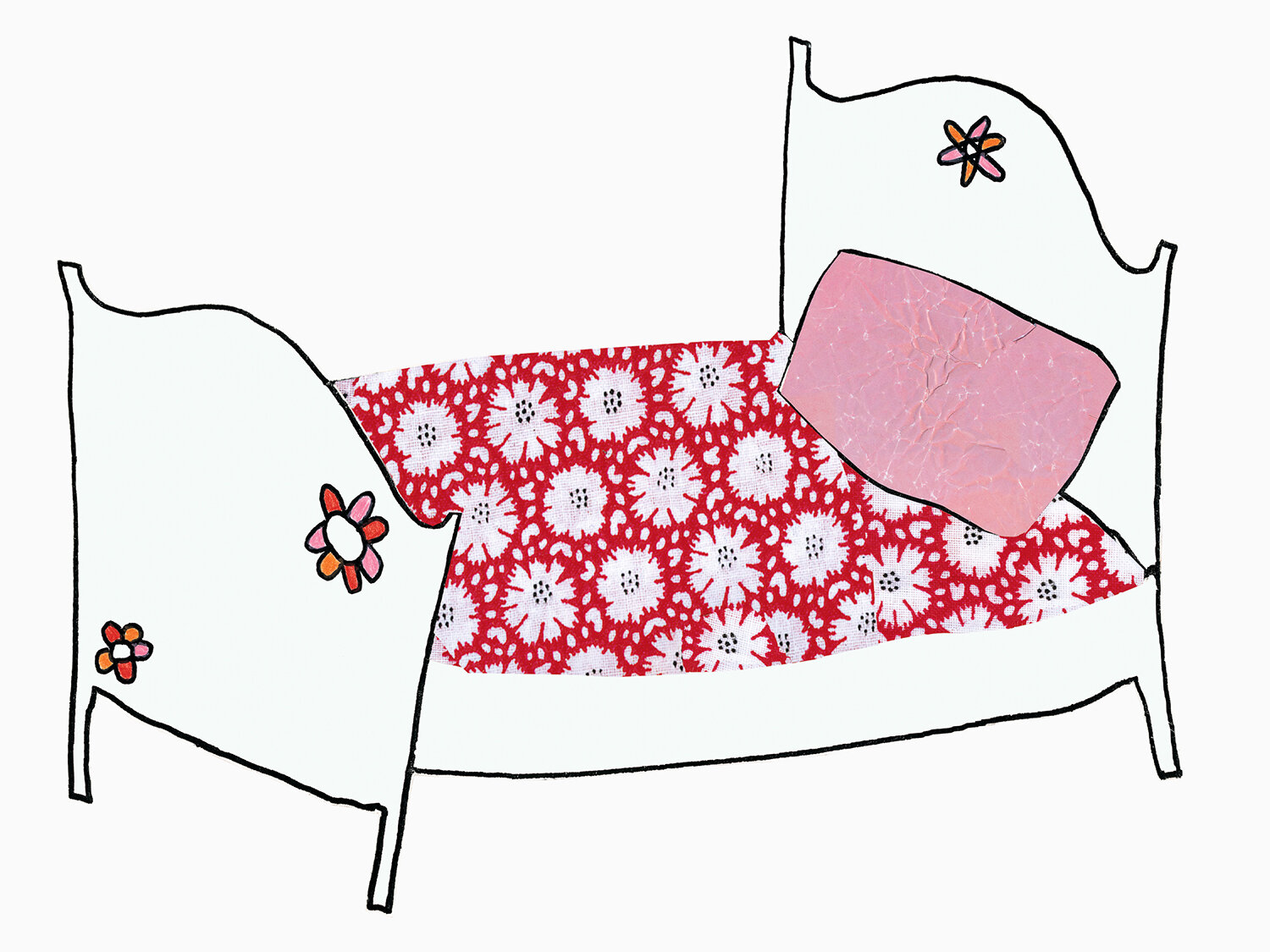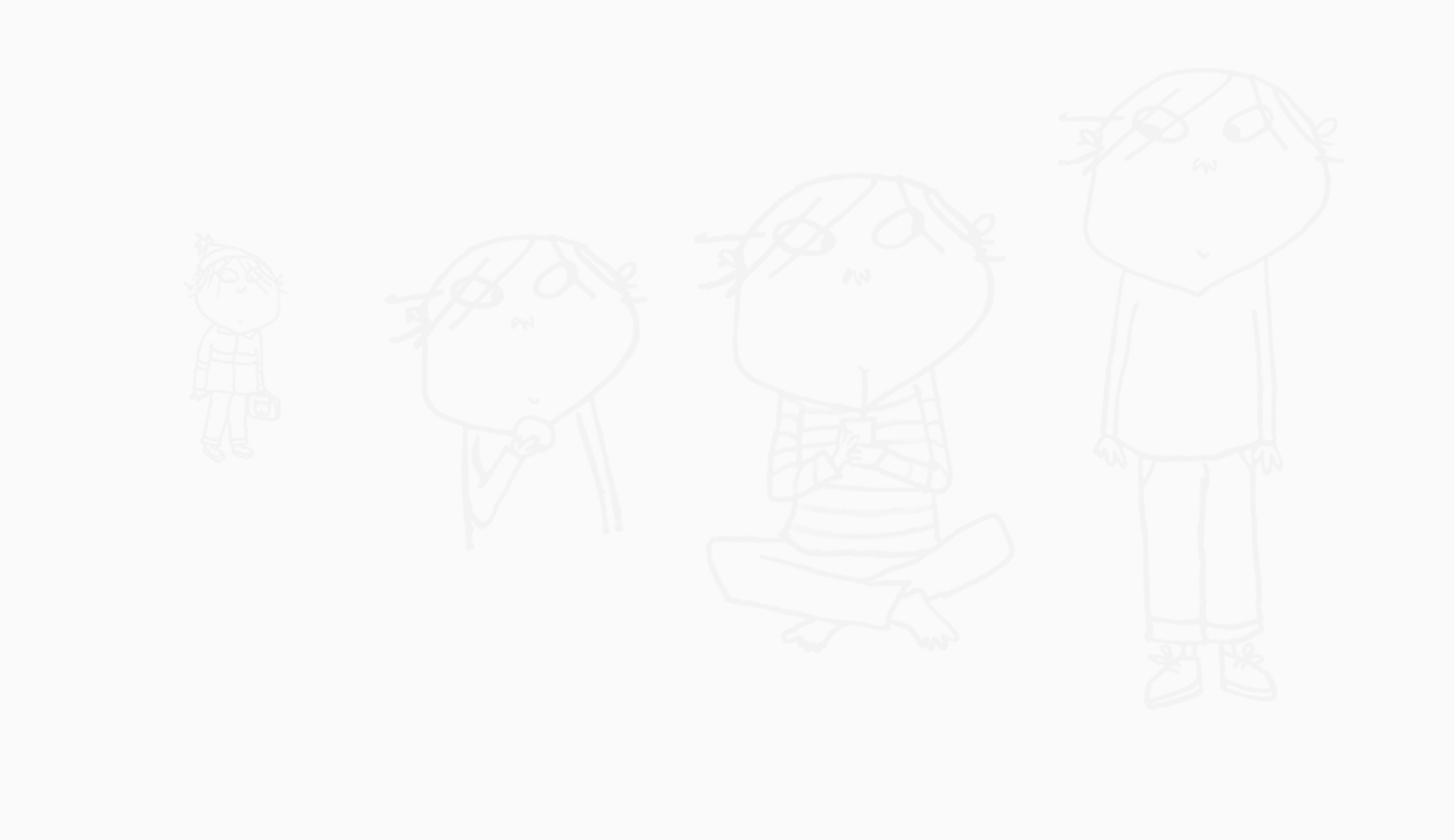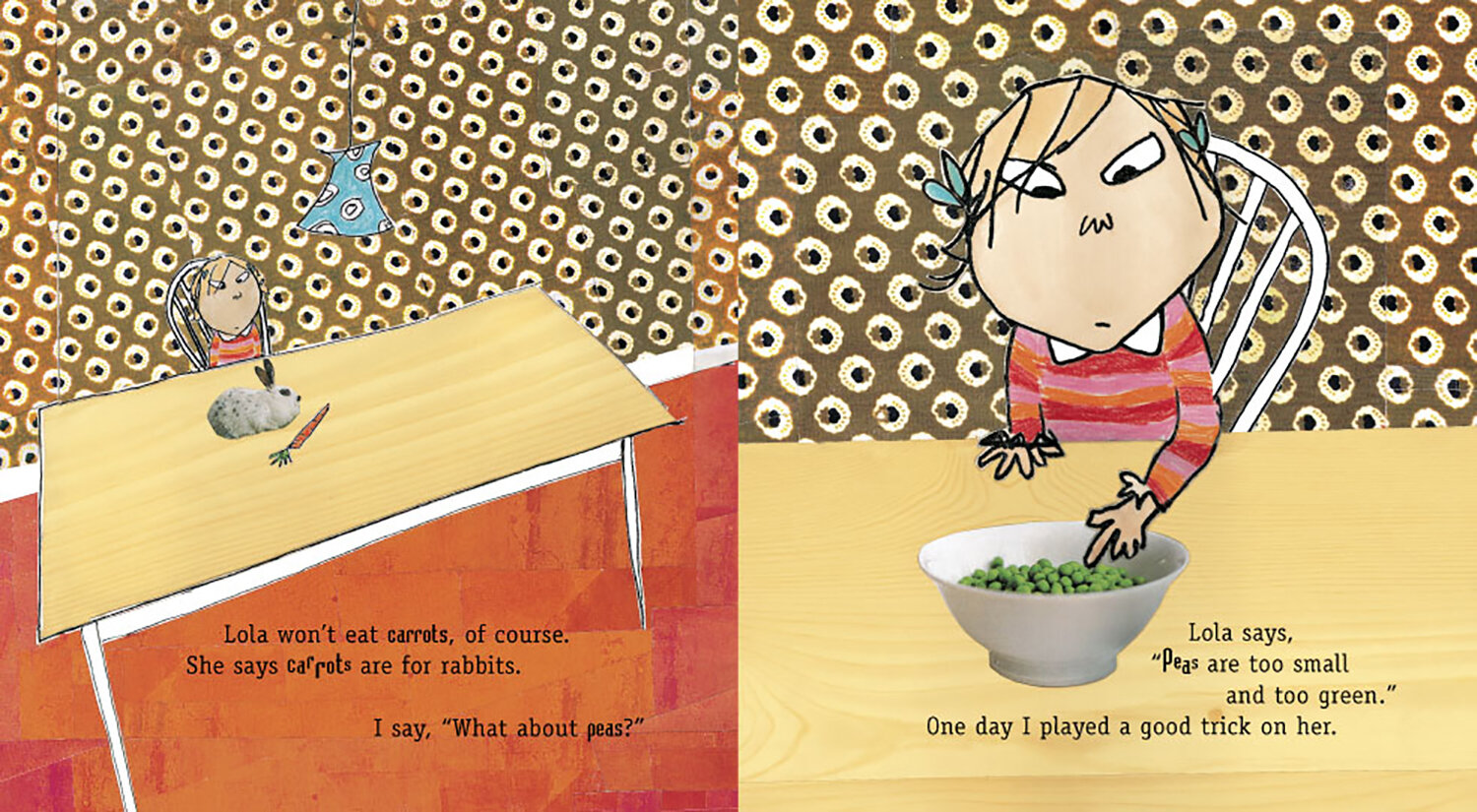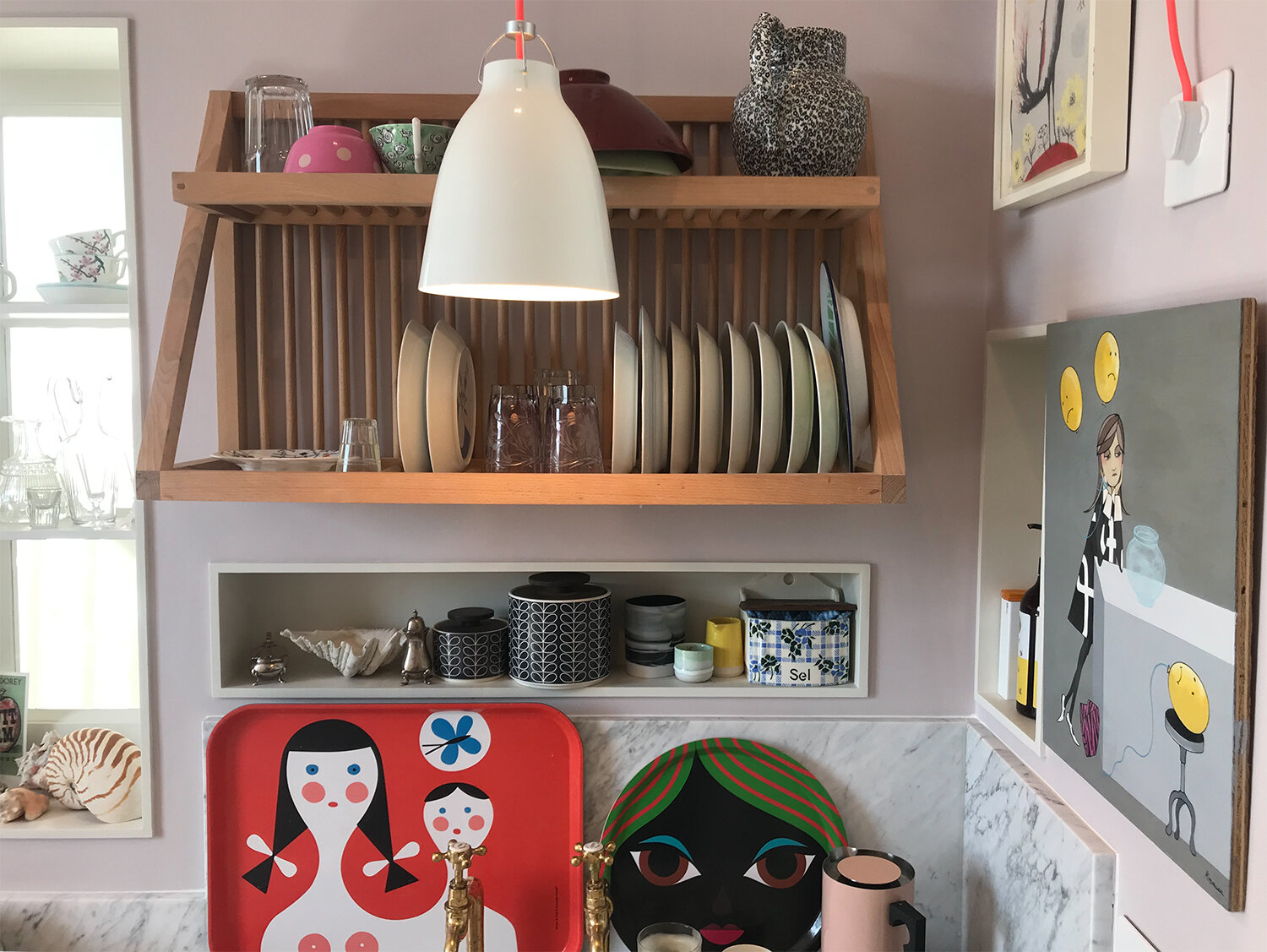Where did the idea come from?
When I was on a train travelling through Denmark, I saw a little girl.
She had very blonde hair and pointy eyes like an elf. She was colouring and sticking while she chatted non-stop her parents were trying very,
very hard to read their books.
Although I couldn’t understand what she was saying there was something about her that was mesmerizing and she had a cheekiness about her that was attractive.
When I got home from my trip I drew her as I remembered her in a little dress with trousers underneath.
This is what I drew.
Then I tried to think of a story that would work with her character. When searching through my notebook, I found the beginnings of a story. It was about two brothers – the younger one was a very, very picky eater and the older one was going to imaginative lengths to persuade him to try just one bite.
As a child, I too was an extremely fussy eater and didn’t like to eat anything if I didn’t know exactly what it was. [Nothing with lumps or bits, nothing mixed together.] This sometimes caused a stalemate between me and my parents; them refusing to let me leave the table until I had cleaned my plate, me resolute that I never would. My older sister was my ally and used to dispose of my food in a handkerchief when my parents turned their backs.
Somehow this felt like the right story for the little Danish girl and somehow it felt right that she would have a loyal older brother. And that’s really how Charlie and Lola began.
I always wanted a brother though I doubt he would have been as nice as Charlie. [Nobody is as nice as Charlie – though my older sister on her best days was a bit like him].
This is the drawing I did of Lola’s brother.
I called him Charlie because I have always liked the name and made him seven because it is one of my favourite ages.
Some people think of Lola as the main character but I never do because it is Charlie’s imagination that drives the stories and they are all told from his point of view, in his voice. They are like a double act and are both equally important.
I never think of Lola as precocious and certainly not bratish – I think she is one of those children who is just very curious and has quite a strong sense of self. Lots of four year olds are like her – four is an age where generally we are still quite free and haven’t yet learned to be self-conscious.
The name Lola has a nice sing-song sound to it and seemed the right name for this little character.
The book, originally titled, My Little Sister and Me became, I Will Not Ever Never Eat a Tomato published in 2000.
Why tomatoes? I hear you ask… Go to Frequently Asked Questions.
I decided to only depict the two children – as if the parents are in another room or just out of sight. I did this because I remember the time I spent with my two sisters – playing, fighting, messing about and I wanted to reflect this in the story. [It went a bit like this: Ow! That really hurt you weasel! You two are driving me crazy! She started it! I don’t care who started it, just stop it!].
My parents were always around somewhere but like most parents they didn’t have hours of time to spend entertaining us. For me, when I look back on my early years, the memories are mainly of time spent with other children.
The Scandinavian Influence
The photograph of the little boy on the dedication page is of my Danish friend Soren. The T-shirt he is wearing, personalised with his name, was very popular in the 70’s – and I decided to put Charlie in the same shirt. In fact there is a retro feel to the whole Charlie and Lola world; it’s a 70’s childhood but with none of the bad things.
Because the drawing and even character of Lola was based on a little Danish girl, I always think of Charlie and Lola as Danish and living in Copenhagen. Since childhood I have been strangely drawn to Scandinavia – strange because I didn’t visit until relatively recently. But perhaps it was to do with book characters like Pippi Longstocking and pictures by the Swedish artist Carl Larsson – and maybe even Habitat which I first visited as a young girl (everything seemed so uplifting, so pine; the design was very Scandinavian so maybe this is part of the link).
The original cover illustrations used in 2015 hardback editions.
The First Three
Charlie and Lola Books
I Will Not Ever Never Eat a Tomato
I had just finished Clarice Bean, That’s Me – quite a complicated book to illustrate and in some ways quite sophisticated in terms of text and typography – and I wanted I Will Not Ever Never Eat a Tomato to have a different feel. The story is simpler and younger than Clarice Bean, That’s Me, the overall feel is less chaotic, easier to read with simpler pictures. I decided to have an introduction to the characters ‘I have this little sister Lola, she is small and very funny’ this gives the book a cosy read-aloud feel.
This is the tomato you see in my first Charlie and Lola book. I accidentally skrunkled it up.
Above: My idea for the cover. Below: I write notes around my pictures to remind to do things.
In all these three Charlie and Lola books, you’ll notice we only leave Charlie and Lola’s home once. With the exception of one trip to school, Charlie and Lola spend all their time in their flat: all the places they visit and the things they see are imagined.
It is quite a challenge writing these books because they follow a very strict pattern; the subject is simple and always about the tiny things in life. Tiny things, which can seem very big when you are four or seven.
Lola’s bed.
I like these toy watches made of plastic, but they keep terrible time.
I Am Not Sleepy And I Will Not Go To Bed
It seemed natural to do a story about not wanting to go to bed – very few children do. I was quite nocturnal as a child and I never looked forward to bedtime as it meant hours of not being able to sleep.
Lola thinks of everything to avoid going to bed.
The bedroom is always green.
The idea for pink milk – Lola’s favourite drink – came from something my friend told me when I was about twelve.
I knew a girl who had a much younger sister – perhaps she was four, maybe five. Her mother would sometimes give her little sister pink milk as a treat. It was just milk with a drop of pink food colouring mixed in. It didn’t taste pink it just looked pink but it was enough to make her think it was something special. Sometimes, when her sister asked if she could have some pink milk, her mother would say, ‘No, it’s only for treats.’
I thought this was very clever, to make ordinary milk exotic, simply by changing it’s colour to pink and pretending that it was very special. I have to say I always imagine that Lola’s pink milk tastes of strawberry, but who knows.
Lola’s pyjamas: to make these I photocopied a little dress that I wore when I was very small indeed. I stitched these up on my sewing machine, but borrowed the little buttons so had to return them.
I Am Too Absolutely Small For School
I wrote this book really because my Australian publisher said there were very few books about starting school, and I thought it was a good storyline for Lola. I did wrestle a bit with the idea of Lola going to school – in some ways it felt wrong because she seems so free of all the anxieties that being at school brings – of ‘fitting in’ and being like everyone else. In the original version, I had her very keen to get her ‘schooliform’ but in the end I changed this to make her dread it because as she says, ‘I do not like wearing the same as other people.’
My rough drawing for the schooliform illustration.
The word Schooliform was invented by my Danish friend Sofie when she was Lola’s age – I think it’s a very good word.
I decided that rather than have her excited about school, I would make her ambivalent, and, to keep Lola feeling like Lola, I would give her an invisible friend. She talks to him when she is feeling worried and he sort of serves to double up her personality and make her stronger.
Where did Soren Lorenson come from?
Soren, the boy in the T shirt, had a little sister called Sofie who would follow him around and would always want to do what Soren was doing.
My friend Sofie. Photo © Soren Lorensen.
Sometimes he didn’t want to do things with Sofie, sometimes he would tell her to leave him alone. So she made up an invisible friend, someone who was always nice to her and always wanted to play with her – he was called Soren Lorensen. I always liked this story of Sofie’s invisible friend.
I thought it was clever of her to come up with an improved brother – one who was always perfect. I thought it would be nice to put Soren Lorensen in this book because it is about Lola starting school and starting anything new can be quite nerve wracking.
Sometimes you wish you could have someone there with you all the time. The great benefit of imaginary friends is, they will always do what you want to do and they will always be there when you need them.
I’ll be adding information about my other three Charlie and Lola books to this page soon. In the meantime, you can visit the books here:
The table at Charlie and Lola’s flat. From A Dog With Nice Ears.
The look of the books
About the settings:
Because the setting is always home I have to think of new ways of showing or referring to the rooms in Charlie and Lola’s flat. Sometimes I show the whole interior sometimes one element. Sometimes I just have an abstract background.
To connect Charlie and Lola’s imaginary world to Charlie and Lola’s ‘real world’, I have the two of them wearing the same clothes in both. So even when they are visiting the supermarket under the sea, they are still dressed in their real life clothes rather than wetsuits.
The other way of connecting them to the real world is to use wallpapers and patterns from their home which then become part of what they are imagining. This way you see how bits and pieces of their everyday life become part of their playful thoughts.
The first page establishes the look of the whole dining room. Then I can just use the lampshade, the table and the chair and you’ll still know which room Lola is in. It’s a useful device!
These are photographic prints of the food I photographed at my kitchen table.
About the illustration
The illustration, as with all my picture books, is collage, but compared to much of my work, the Charlie and Lola pictures are quite pared back and the overall look is cleaner and clearer. I have used a lot of textures and patterns which contrast with the simple drawings of the two children.
As a rule, the photographic images are there to highlight the subject.
So when Lola is talking about a particular food that she won’t eat, I have photographed it and stuck it into the picture.
Objects and things I have around me seem to work their way into my books, influencing my drawings and palette. The pink milk glass was from a set that I bought in a charity shop. I liked the way the milk showed behind the flowers. The brown spot wallpaper is made up from a tiny scrap of fabric, used to cover a lampshade which was made during my time as a lampshade designer. Likewise the pink wallpaper was also a lampshade.










